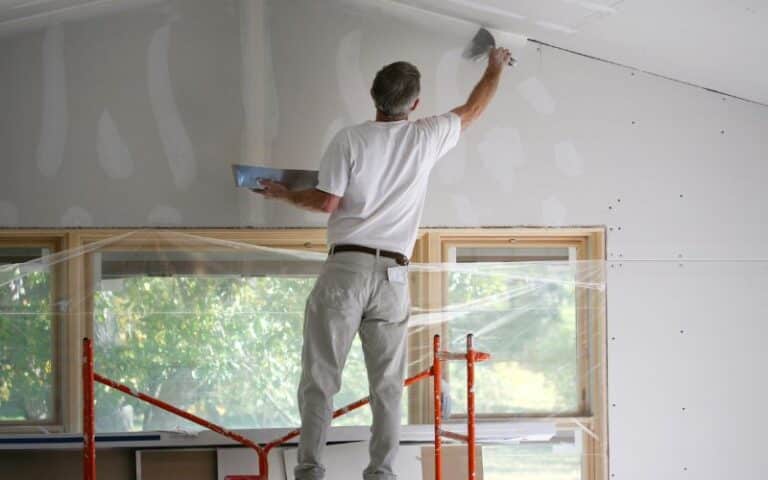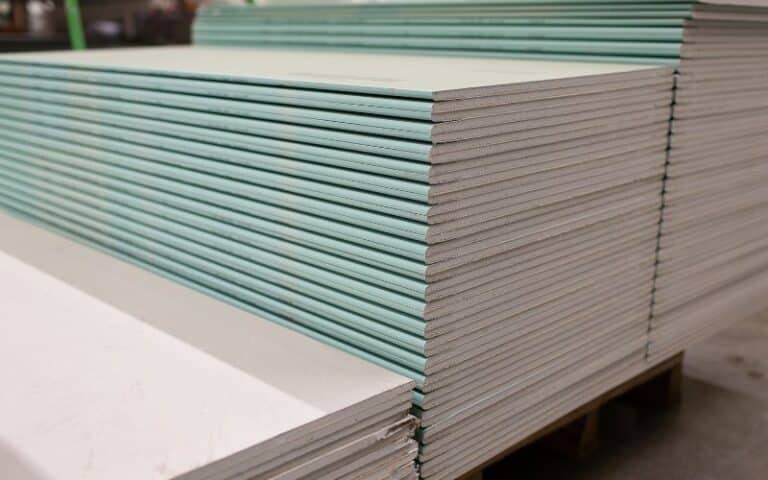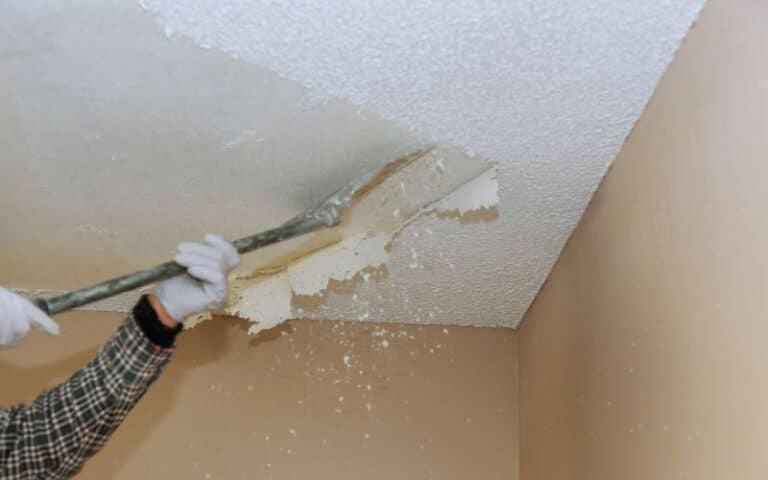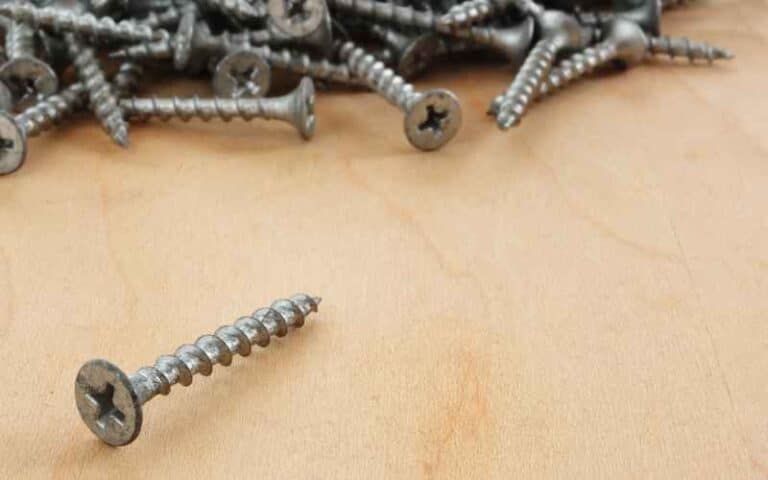The regular drill and the drywall screw gun tasks are very similar. However, there are a few differences between them.
Although people often mix them up, each one is great at performing practical tasks that the other can not accomplish.
A drill primarily functions for making round holes and driving screws through, but more than that, they are more versatile since they can perform both functions as well.
Yes, you can use a regular drill for drywall, although a professional drywall installer will prefer to use a screw gun because it can automatically regulate screw depth. However, most DIY homeowners will use the available cordless drill, and with some care, you will drive the screws precisely without punching through the paper.
This article aims to see if you can use a regular drill or impact driver for drywall and the best drill bit.
Consequently, we will see if pilot holes are necessary for drywalls.
Ready for a Drywall Quiz?
Can a Regular Drill Be Used for Drywall?
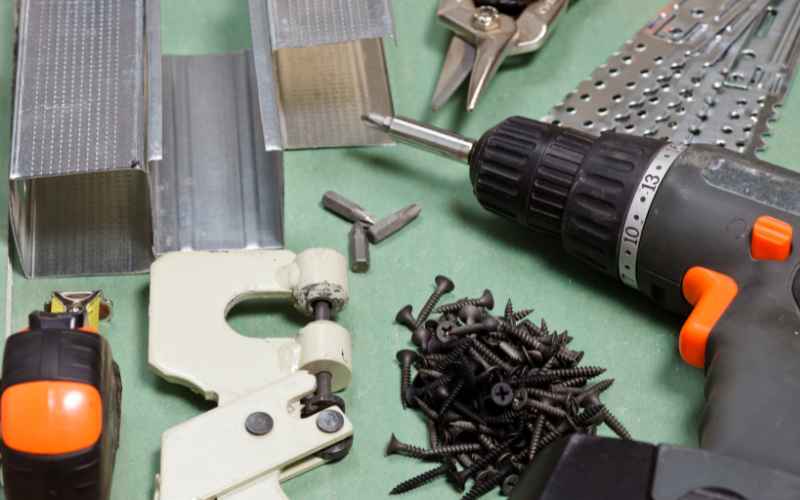
As with the point above, most DIYers make use of the regular drill since it may be easily accessible to them at home. All that is required is your care and full attention during the process.
If you fail to provide the needed and complete attention while using the drill, there will likely be a punch-through. Which will ruin the entire work you are performing.
Unlike screw guns, the regular drill can not automatically regulate screw depth. However, using a drywall screw extension with a regular drill can greatly reduce punch-through chances.
For instance, let us say we are dealing with a ½-inch thick drywall panel; you need a 1 ¼ or 1 ⅜-inch screw, while drywall panels of ⅝-inch need 1 ⅜ or 1 ⅝-inch screw.
You can get drywall screws as either coarse thread or delicate thread designs. I recommend you use a coarse thread design if you are working on wooden studs.
Due to how aggressively the coarse thread drives down the wood, it will reduce the physical strength that the drill requires to push the screw into the wood.
Similarly, the fine thread screw is more useful when attaching your panels to metal studs. Again, the fine thread designs are far more effective on metal studs than wood.
How to use a regular drill on drywall?
#1. Determine Screwing Interval
The best thing would be to drive the screws at every interval 8 inches into the drywall panel at the edges and then 16 inches in its center.
So 32 screws should be just enough for a 4 x 8-foot sheet of drywall.
For the ceiling panel, you should remain with the 8-inch interval for the edges and 12 inches for the center.
And ensure that your screwing points stay close enough to avoid damaging your drywall panel’s edges.
Many professionals use their eyes to set the intervals, but I suggest you make markings of the points first with a pencil. It will improve your chances of driving the screws through the studs.
#2. Wall Illumination
If you want to quickly and accurately measure how deep the screw goes as you drive it in, make sure you use a sidelight on the wall.
No ordinary lamp will have light strong enough to help you walk on the wall and fully accomplish your task, which is why I recommend a painter’s work light.
#3. Set Up Drill
Pick up your drill, place the screw bit of Phillips’s head on it, and ensure it has not worn out (note that if you have a drywall extension bit, you can decide to attach it to the drill ).
For a better grip, add a side handle if your drill does have it. Where the clutch is adjustable, you can reduce torque to the lowest level and stop the drill from driving screws too far down.
#4. Start Screwing
Begin driving the screw at a slow speed but ensure that your weight is leaning toward your drill.
With insufficient pressure, the head of the screw may be lost as it goes farther down the wood.
The higher the pressure you bring, the more you will have far better control until the head of the screw approaches the paper. While driving, ensure to observe the screw’s progress also.
#5. Finish Up the Screwing
As the screw head reaches the drywall and it appears to be a simple, slowly bring the drill to a stop. If the screw fits perfectly, then the paper’s edges all over it will sink inward.
A sharp edge within the screw will mean the screw has gone down too deep.
However, if the drive does not go far enough, then using a taping compound to cover the screw head will become impossible.
To avoid puncturing the drywall and driving the screw too deep down into the gypsum area of your drywall panel. A sound that appears like a pop will mean a puncture of the paper by a screw head.
You can address this issue by driving another screw close to the previous one. But remember to remove the damaged screw and, in the end, fill the hole with a taping compound.
If you are thinking of a regular drill on drywall, you should, first of all, weigh the pros and cons of it.
Below is a table that shows the pros and cons of a regular drill
| Pros | Cons |
|---|---|
| Easy access to it | The add-ons are expensive |
| More versatile | You can’t set drive depth with it |
| Can drive almost everything | |
| Exist with many types |
What Kind of Drill Bit Do I Use for Drywall?
The effort you put into choosing a drill bit is not because of how rigid your drywall is; the drywall is relatively easy to drill a hole through it.
But the best drill bit will help you make the precise hole you need.
So whether you are making a hole to hang, attach, or mount something, you need the best drill bit for the particular task you want to perform.
For instance, the best drill bit endpoint for household tasks is the 1/16-inch to ½-inch. However, it would be best to have a 5/16-inch to a ½-inch drill bit for challenging drilling applications.
Note that for drywall screw guns, when you buy them, they usually come with a number 2 screw bit.
So if you find one with a different head bit, it is probably for some other construction application.
To use the right drill bit, you must confirm whether the surface you are working on is drywall.
A wall that produces a hollow sound when you knock on it is probably drywall, and with the aid of the drill bit, you can produce regular size holes on it.
However, a wood drill bit is ideal if you intend to drill past drywall and into a stud. You need a screwdriver and a suitable drywall anchor to hang something on the wall.
Depending on what you are looking for, various drill bits may appeal to you.
Below are some of my top picks for you:
- Top pick for drill bit- Makita: Best Insert Drill Bit for Drywall
- Second best pick- DEWALT: Masonry Drill Bits Set for Drywall.
- Best premium pick- DEWALT: Drill Bit for Drywall Anchor
- Best for drilling drywall- Owl Tools: Masonry Drill Bits for Drywall
- Best overall- ARROW: Best Drill Bit for Drywall Screws and Anchor Kit
Should I Use a Drill or Impact Driver for Drywall?
From the above, you can see that using a regular drill to work on drywall is very much possible. But then the question is, will an impact driver perform better than a drill?
Well, I will never recommend that you never use an impact driver when working on drywall. The reason is that its design does not suit a task on drywall.
The impact driver operates at high torque levels with poor control, while the regular drill has accurate speed and torque control.
And this means impact drivers will perform very poorly regarding precision with depth. Drywall screws are supposed to meet little resistance as they go into wall studs.
However, an impact driver will hammer into the drywall with a high torque level, making it difficult to control the depth.
Are Pilot Holes Necessary for Drywall?
Pilot holes are not always necessary. However, they become necessary when drilling into a laminate or hardwood or needing a precisely located fastener.
It is best to use pilot holes on drywall if you are also drilling on wood that will most likely crack or drilling where appearance matters.
However, if you are working on softwood or where appearance doesn’t matter, you may decide not to use the pilot holes.
FAQs
Why Are Drywall Screws So Hard?
They are hard, so the Phillips slot will not be able to come out under the stress of high-speed screw guns and drills. Wood screws are made from softer metal but thicker.
Is Drywall Too Hard to Drill Through?
The drywall is so soft to drill into that you can even drill through it with a dull drill bit. But for efficiency and precision, you should use a sharp drill on drywall.



